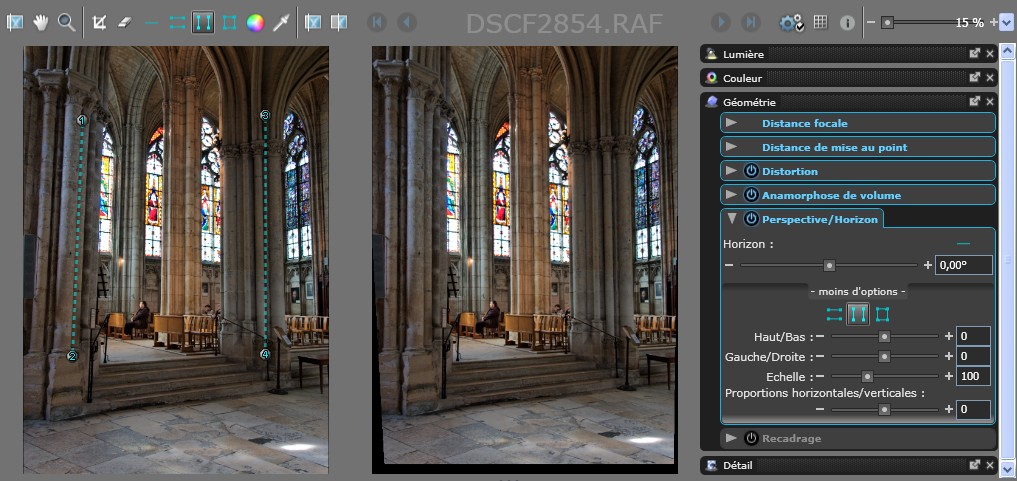

- DXO PERSPECTIVE MAC OS X
- DXO PERSPECTIVE MANUAL
- DXO PERSPECTIVE FULL
- DXO PERSPECTIVE SOFTWARE
- DXO PERSPECTIVE WINDOWS 8
You an also fine tune the effect with the Angle slider, which has an editable numeric readout, too. Horizon actually straightens the image either horizontally (as in a horizon) or vertically.
DXO PERSPECTIVE FULL
And intensity fades the full effect back toward the original. H/V Ratio changes the ratio of horizontal to vertical. In addition, there are four sliders to adjust the effect. Keystoning offers three options: vertical, horizontal and both simultaneously, which is great for windows and artwork. The two options correct a horizontal stretch and a diagonal stretch. So to correct an image, you have three options:Īnamorphic corrections just require a click for the kind of correction you want to make.
DXO PERSPECTIVE SOFTWARE
That's a welcome feature because you can fill in corners with modern image editing software so you don't have to live with a tight crop.
DXO PERSPECTIVE MANUAL
Some applications make this crop for you automatically but ViewPoint lets you see your options so you can make a manual crop. The keystoning corrections require a crop to return the image to a rectangular format. Straighten the image either horizontally or vertically.

The correction takes a bit of time to process the image. You can correct each problem individually or both at one time. And if you are not standing square to the building, the horizontals will converge as they run away from you. The Keystoning tool corrects that convergence. Pointing your camera up at the front of a building causes the vertical lines in the image to converge near the top. And restores the shape of their heads, too. This tool makes them circles again (almost instantly). If the guys on the ends were holding plates, they wouldn't be circles but ovals. The typical example is a group of people. This tool corrects the geometric distortion caused by a wide angle lens on object at the far edges of the image. ViewPoint brings a few tools to the party:

And that can, in fact, change the meaning of the image. The second meaning is the photographer's position.īy changing perspective, ViewPoint does indeed seem to move the camera position. The first meaning of ViewPoint is the meaning of a photo. That all worked as it should in the modern world.ĭxO told us the name has a double meaning reflecting the changes the software can make to an image. In fact, we were pleased to see the installer found our plug-ins folder and recognized which applications we could use ViewPoint in.Īnd we were glad ViewPoint alerted us to the update, too. We had no issues with the installation or update. We installed a beta version of the software, both the standalone and plug-in flavors. A subsequent Save command in ViewPoint returns you to your main application. It warns you that you're leaving your main application to use ViewPoint. The plug-in, which is included with the standalone version, works in Photoshop CS3 to CS6 and Lightroom 3 and 4.
DXO PERSPECTIVE WINDOWS 8
DxO expects it to be compatible with Windows 8 when released, as well.
DXO PERSPECTIVE MAC OS X
ViewPoint runs on Mac OS X version 10.5 through 10.8 and Windows XP/Vista/7. The software is easy to use and, based on technology that's been in the company's flagship product Optics Pro, very reliable. Better to blame the camera than you.ĭxO's ViewPoint makes it simple to fix these things and keep them looking natural. Even if you happen to get it right, it looks disturbingly unnatural. It's notoriously difficult to successfully correct them. If you dare try to correct these geometric distortions in your image editor with a Perspective control, say, you probably didn't dare twice. If it's a group of people, the guys on the end will have their heads reshaped in grotesque ways. That's the distortion of things at the left and right edges of the image. If you do that to people by shooting from a low angle, their heads are ridiculously tiny compared to their hands, say.īut the one no one laughs about is becoming increasingly common as zoom lenses get wider and wider. Unfortunately all the verticals that are obviously parallel in real life, converge almost comically in your photo as they rise. You're standing in front of a famous building, you whip out your camera and, point up to include the roof line, you shoot. The most common distortion is one you may not even be bothered by: converging verticals. That pretty much sums up our smile as we sat through a briefing on DxO Labs' new tool to fix some distortions we've all had to live with for a while.


 0 kommentar(er)
0 kommentar(er)
